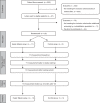Effects of task-oriented robot training on arm function, activity, and quality of life in chronic stroke patients: a randomized controlled trial
- PMID: 24684808
- PMCID: PMC3973831
- DOI: 10.1186/1743-0003-11-45
Effects of task-oriented robot training on arm function, activity, and quality of life in chronic stroke patients: a randomized controlled trial
Abstract
Background: Over fifty percent of stroke patients experience chronic arm hand performance problems, compromising independence in daily life activities and quality of life. Task-oriented training may improve arm hand performance after stroke, whereby augmented therapy may lead to a better treatment outcome. Technology-supported training holds opportunities for increasing training intensity. However, the effects of robot-supported task-oriented training with real life objects in stroke patients are not known to date. The aim of the present study was to investigate the effectiveness and added value of the Haptic Master robot combined with task-oriented arm hand training in chronic stroke patients.
Methods: In a single-blind randomized controlled trial, 22 chronic stroke patients were randomly allocated to receive either task-oriented robot-assisted arm-hand training (experimental group) or task-oriented non-robotic arm-hand training (control group). For training, the T-TOAT (Technology-supported Task-Oriented Arm Training) method was applied. Training was provided during 8 weeks, 4 times/week, 2 × 30 min/day.
Results: A significant improvement after training on the Action Research Arm Test (ARAT) was demonstrated in the experimental group (p = 0.008). Results were maintained until 6 months after cessation of the training. On the perceived performance measure (Motor Activity Log (MAL)), both, the experimental and control group improved significantly after training (control group p = 0.008; experimental group p = 0.013). The improvements on MAL in both groups were maintained until 6 months after cessation of the training. With regard to quality of life, only in the control group a significant improvement after training was found (EuroQol-5D p = 0.015, SF-36 physical p = 0.01). However, the improvement on SF-36 in the control group was not maintained (p = 0.012). No between-group differences could be demonstrated on any of the outcome measures.
Conclusion: Arm hand performance improved in chronic stroke patients, after eight weeks of task oriented training. The use of a Haptic Master robot in support of task-oriented arm training did not show additional value over the video-instructed task-oriented exercises in highly functional stroke patients.
Clinical trial registration information: Current Controlled Trials ISRCTN82787126.
Figures
References
-
- Ali M, Atula S, Bath PM, Grotta J, Hacke W, Lyden P, Marler JR, Sacco RL, Lees KR. Stroke outcome in clinical trial patients deriving from different countries. Stroke. 2009;40(1):35–40. - PubMed
-
- Bejot Y, Benatru I, Rouaud O, Fromont A, Besancenot JP, Moreau T, Giroud M. Epidemiology of stroke in Europe: geographic and environmental differences. J Neurol Sci. 2007;262(1–2):85–88. - PubMed
-
- Broeks JG, Lankhorst GJ, Rumping K, Prevo AJ. The long-term outcome of arm function after stroke: results of a follow-up study. Disabil Rehabil. 1999;21(8):357–364. - PubMed
-
- Lai SM, Studenski S, Duncan PW, Perera S. Persisting consequences of stroke measured by the stroke impact scale. Stroke. 2002;33(7):1840–1844. - PubMed
-
- Johansson A, Mishina E, Ivanov A, Bjorklund A. Activities of daily living among St Petersburg women after mild stroke. Occup Ther Int. 2007;14(3):170–182. - PubMed
Publication types
MeSH terms
Associated data
LinkOut - more resources
Full Text Sources
Other Literature Sources
Medical
Research Materials



